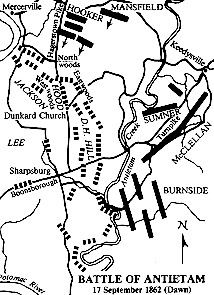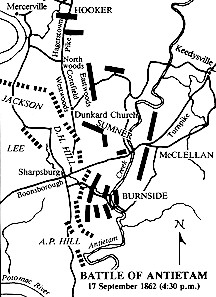![]()
On September 16, Maj. Gen. George B. McClellan confronted Lee's Army of Northern Virginia at Sharpsburg, Maryland. At dawn September 17, Hooker's corps mounted a powerful assault on Lee's left flank that began the single bloodiest day in American military history. Attacks and counterattacks swept across Miller's cornfield and fighting swirled around the Dunker Church. Union assaults against the Sunken Road eventually pierced the Confederate center, but the Federal advantage was not followed up. Late in the day, Burnside's corps finally got into action, crossing the stone bridge over AntietamCreek and rolling up the Confederate right. At a crucial moment, A.P. Hill's division arrived from Harpers Ferry and counterattacked, driving back Burnside and saving the day. Although outnumbered two-to-one, Lee committed his entire force, while McClellan sent in less than three-quarters of his army, enabling Lee to fight the Federals to a standstill. During the night, both armies consolidated their lines. In spiteof crippling casualties, Lee continued to skirmish with McClellan throughout the 18th, while removing his wounded south of the river. McClellan did not renew the assaults. After dark, Lee ordered the battered Army of Northern Virginia to withdraw across the Potomac into the Shenandoah Valley.
Result(s): Inconclusive (Union strategic victory.)
Other Names: Sharpsburg
Location: Washington County
Campaign: Maryland Campaign (September 1862)
Date(s): September 16-18, 1862
Principal Commanders: Maj. Gen. George B. McClellan [US]; Gen. Robert E. Lee [CS]
Forces Engaged: Armies
Estimated Casualties: 23,100 total
CWSAC Reference #: MD003
Source:
![]()
The Battle of Antietam, was fought on Sept. 17, 1862, between the U.S. Army of the Potomac under Gen. George B. McClellan and the Confederate Army of Northern Virginia under Gen. Robert E. Lee. Lee's first invasion of the North culminated in the worst day of fighting to that time at Sharpsburg, Md., along Antietam Creek. McClellan concentrated near Sharpsburg after a rapid march from Washington. Lee, having dispersed his army for mopping-up operations from Harper's Ferry to Martinsburg, Va., also concentrated at Sharpsburg. Lee narrowly escaped defeat. Although McClellan's casualties were heavier (12,000 men), Lee's loss of 10,000 men forced a Confederate retreat to Virginia.
The Battle of Antietam (or Sharpsburg) on September 17, 1862, climaxed the first of Confederate Gen. Robert E. Lee's two attempts to carry the war into the North. About 40,000 Southerners were pited against the 87,000-man Federal Army of the Potomac under Gen. George B. McClellan. And when the fighting ended, the course of the American Civil War had been greatly altered.
After his great victory at Manassas in August, Lee had marched his Army of Northern Virginia into Maryland, hoping to find vitally needed men and supplies. McClellan followed, first to Frederick (where through rare good fortune a copy of the Confederate battle plan, Lee's Special Order No. 191, fell into his hands), then westward 12 miles to the passes of South Mountain. There on September 14, at Turner's, Fox's, and Crampton's gaps, Lee tried to block the Federals. But because he had split his army to send troops under Gen. Thomas J. "Stonewall" Jackson to capture Harpers Ferry, Lee could only hope to delay the Northerners. McClellan forced his way through, and by the afternoon of September 15 both armies had established new battielines west and east of Antietam Creek near the town of Sharpsburg. When Jackson's troops reached Sharpsburg on the 16th, Harpers Ferry having surrendered the day before, Lee consolidated his position along the low ridge that runs north and south of the town.
 The battle opened at dawn on the 17th when Union Gen. Joseph Hooker's artillery
began a murderous fire on Jackson's men in the Miller cornfield north of town. "In
the time I am writing," Hooker reported, "every stalk of corn in the northern and
greater part of the field was cut as closely as could have been done with a knife,
and the slain lay in rows precisely as they had stood in their ranks a few moments
before." Hooker's troops advanced, driving the Confederates before them, and Jackson
reported that his men were "exposed for near an hour to a terrific storm of shell,
canister, and musketry."
The battle opened at dawn on the 17th when Union Gen. Joseph Hooker's artillery
began a murderous fire on Jackson's men in the Miller cornfield north of town. "In
the time I am writing," Hooker reported, "every stalk of corn in the northern and
greater part of the field was cut as closely as could have been done with a knife,
and the slain lay in rows precisely as they had stood in their ranks a few moments
before." Hooker's troops advanced, driving the Confederates before them, and Jackson
reported that his men were "exposed for near an hour to a terrific storm of shell,
canister, and musketry."
About 7 a.m. Jackson was reenforced and succeeded in driving the Federals back. An hour later Union troops under Gen. Joseph Mansfield counterattacked and by 9 o'clock had regained some of the lost ground. Then, in an effort to extricate some of Mansfield's men from their isolated position near the Dunker Church, Gen. John Sedgwick's division of Edwin V. Sumner's corps advanced into the West Woods. There Confederate troops struck Sedgwick's men on both flanks, inflicting appalling casualties.
Meanwhile, Gen. William H. French's division of Sumner's corps moved up to support Sedgwick but veered south into Confederates under Gen. D. H. Hill posted along an old sunken road separating the Roulette and Piper farms. For nearly 4 hours, from 9:30 a.m. to 1 p.m., bitter fighting raged along this road (afterwards known as Bloody Lane) as French, supported by Gen. Israel B. Richardson's division, also of Sumner's corps, sought to drive the Southerners back. Confusion and sheer exhaustion finally ended the battle here and in the northern part of the field generally.
 Southeast of town, Union Gen. Ambrose E. Burnside's troops had been trying to cross
a bridge over antietam Creek since 9:30 a.m. Some 400 Georgians had driven them back
each time. At 1 p.m. the Federals finally crossed the bridge (now known as Burnside
Bridge) and, after a 2-hour delay to reform their lines, advanced up the slope
beyond. By late afternoon they had driven the Georgians back almost to Sharpsburg,
threatening to cut off the line of retreat for Lee's decimated Confederates. Then
about 4 p.m. Gen. A. P. Hill's division, left behind by Jackson at Harpers Ferry to
salvage the captured Federal property, arrived on the field and immediately entered
the fight. Burnside's troops were driven back to the heights near the bridge they
had earlier taken. The Battle of Antietam was over. The next day Lee began
withdrawing his army across the Potomac River.
Southeast of town, Union Gen. Ambrose E. Burnside's troops had been trying to cross
a bridge over antietam Creek since 9:30 a.m. Some 400 Georgians had driven them back
each time. At 1 p.m. the Federals finally crossed the bridge (now known as Burnside
Bridge) and, after a 2-hour delay to reform their lines, advanced up the slope
beyond. By late afternoon they had driven the Georgians back almost to Sharpsburg,
threatening to cut off the line of retreat for Lee's decimated Confederates. Then
about 4 p.m. Gen. A. P. Hill's division, left behind by Jackson at Harpers Ferry to
salvage the captured Federal property, arrived on the field and immediately entered
the fight. Burnside's troops were driven back to the heights near the bridge they
had earlier taken. The Battle of Antietam was over. The next day Lee began
withdrawing his army across the Potomac River.
More men were killed or wounded at Antietam on September 17, 1862, than on any other single day of the Civil War. Federal losses were 12,410, Confederate losses 10,700. Although neither side gained a decisive victory, Lee's failure to carry the war effort effectively into the North caused Great Britain to postpone recognition of the Confederate government. The battle also gave President Abraham Lincoln the opportunity to issue the Emancipation Proclamation, which, on January 1, 1863, declared free all slaves in States still in rebellion against the United States. Now the war had a dual purpose: to preserve the Union and end slavery.
Source:
Last Updated 09 April 2002
It was the best of times, it was the worst of times
Click on any [Item] below to go to that page
[Return to Glossary Page]
[Return to 43rd Pennsylvania Home Page]

© 1998-2004 Benjamin M. Givens, Jr.
![]()